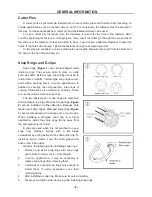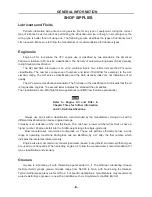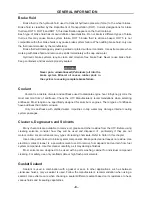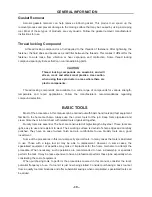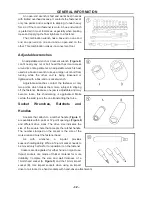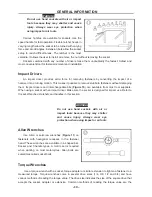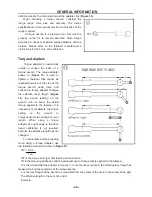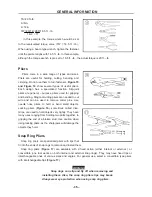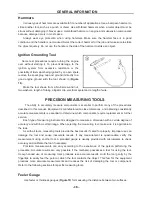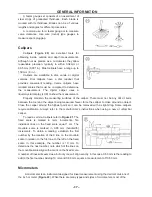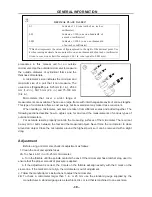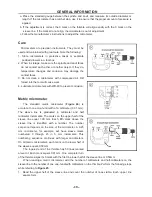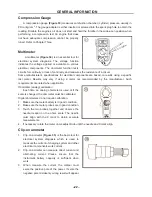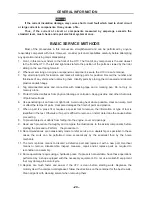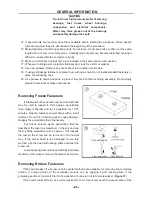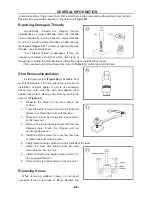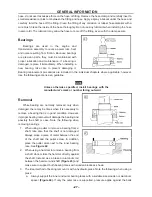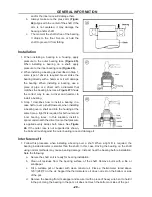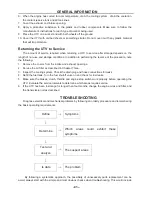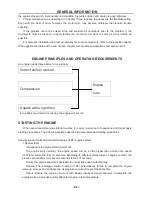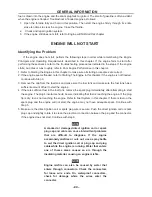
-19-
GENERAL INFORMATION
- 19 -
a. Place the standard gauge between the spindle and anvil, and measure its outside diameter or
length. If the micrometer has a ratchet stop, use it to ensure that the proper amount of pressure is
applied.
b. If the adjustment is correct, the 0 mark on the thimble will align exactly with the 0 mark on the
sleeve line. If the marks do not align, the micrometer is out of adjustment.
c. Follow the manufacturer’s instructions to adjust the micrometer.
Care
Micrometers are precision instruments. They must be
used and maintained with great care. Note the following:
1. Store micrometers in protective cases or separate
padded drawers in a tool box.
2. When in storage, make sure the spindle and anvil faces
do not contact each other or another object. If they do,
temperature changes and corrosion may damage the
contact faces.
3. Do not clean a micrometer with compressed air. Dirt
forced into the tool will cause wear.
4. Lubricate micrometers with WD-40 to prevent corrosion.
Metric micrometer
The standard metric micrometer (
Figure 24
)
is
accurate to one one-hundredth of a millimeter (0.01 mm).
The sleeve line is graduated in millimeter and half
millimeter increments. The marks on the upper half of the
sleeve line equal 1.00 mm. Each fifth mark above the
sleeve line is identified with a number. The number
sequence depends on the size of the micrometer. A 0-25
mm micrometer, for example, will have sleeve marks
numbered 0 through 25 in 5 mm increments. This
numbering sequence continues with larger micrometers.
On all metric micrometers, each mark on the lower half of
the sleeve equals 0.50 mm.
The tapered end of the thimble has 50 lines marked
around it. Each mark equals 0.01 mm. One completer turn
of the thimble aligns its 0 mark with the first line lower half of the sleeve line or 0.50mm.
When reading a metric micrometer, add the number of millimeters and half-millimeters on the
sleeve line to the number of one one-hundredth millimeters on the thimble. Perform the following steps
while referring to
Figure 25
.
1. Read the upper half of the sleeve line and count the number of lines visible. Each upper line
equals 1mm.
Summary of Contents for HS200UTV
Page 3: ......
Page 15: ......
Page 94: ... 79 SPECIFICATIONS 79 HYDROGRAPHIC CHART Hydrographic chart Pressure ...
Page 95: ... 80 SPECIFICATIONS 80 LUBRICATION OIL WAY LUBRICATION OIL WAY Pressure splashing oil ...
Page 248: ... 233 CHASSIS 233 Fuel tank cap Remove the fuel tank cap by turning it counterclockwise ...
Page 263: ... 248 ...
Page 304: ... 289 ...
Page 305: ... 290 ...
Page 306: ... 291 ...
Page 307: ... 292 ...
Page 308: ... 293 ...
Page 309: ... 294 ...
Page 310: ... 295 ...
Page 311: ... 296 ...



